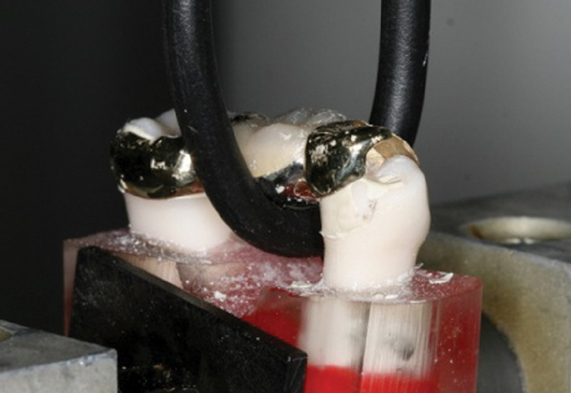J Adv Prosthodont.
2009 Jul;1(2):85-90. 10.4047/jap.2009.1.2.85.
Dislodgement resistance of modified resin-bonded fixed partial dentures utilizing tooth undercuts: an in vitro study
- Affiliations
-
- 1Department of Prosthodontics, School of Dentistry, Yonsei University, Seoul, Korea. kwlee@yuhs.ac
- KMID: 2045468
- DOI: http://doi.org/10.4047/jap.2009.1.2.85
Abstract
- STATEMENT OF PROBLEM: Over the years, resin-bonded fixed partial dentures (RBFPDs) have gone through substantial development and refinement. Several studies examined the biomechanics of tooth preparation and framework design in relation to the success rate of RBFPDs and considered retention and resistance form essential for increase of clinical retention. However, these criteria required preparations to be more invasive, which violates not only the original intentions of the RBFPD, but may also have an adverse effect on retention due to loss of enamel, an important factor in bonding. PURPOSE: The object of this in vitro study was to compare the dislodgement resistance of the new types of RBFPDs, the conventional three-unit fixed partial denture, and conventional design of RBFPD (Maryland bridge). MATERIAL AND METHODS: Fifty resin mandibular left second premolars and second molars were prepared on dentiforms, according to the RBFPD design. After model fabrication (five group, n = 10), prostheses were fabricated and cemented with zinc phosphate cement. After cementation, the specimens were subjected to tensile loading at a cross head speed of 4 mm/min in a universal testing machine. The separation load was recorded and analyzed statistically using one-way analysis of variance followed by Duncan's multiple range test. RESULTS: Group V, the pin-retained RBFPDs, had the highest mean dislodgement resistance, whereas specimens of group II, the conventional RBFPDs, exhibited a significantly lower mean dislodgement resistance compared to the other 4 groups (P < .05). There were no significant differences between group I, III, and IV in terms of dislodgement resistance (P > .05). Group V had the highest mean MPa (N/mm2) (P < .05). There was no significant difference between groups I, II, III and IV (P > .05). CONCLUSION: Within the limits of the design of this in vitro study, it was concluded that: 1. The modified RBFPDs which utilizes the original tooth undercuts and requires no tooth preparation, compared with the conventional design of RBFPDs, has significantly high dislodgement resistance (P < .05). 2. The modified RBFPDs which utilizes the original tooth undercuts and requires minimal tooth preparation, compared with the conventional FPDs, has significantly no difference in retention and dislodgement resistance)(P > .05). 3. The pin-retained FPDs showed a high dislodgement resistance compared to the conventional three-unit FPDs (P < .05).
MeSH Terms
Figure
Reference
-
1. Rochette AL. Attachment of a splint to enamel of lower anterior teeth. J Prosthet Dent. 1973. 30:418–423.2. Howe DF, Denehy GE. Anterior fixed partial dentures utilizing the acid-etch technique and a cast metal framework. J Prosthet Dent. 1977. 37:28–31.3. Livaditis GJ. Cast metal resin-bonded retainers for posterior teeth. J Am Dent Assoc. 1980. 101:926–929.4. Barrack G. A lood back at the adhesive resin-bonded cast restoration. J Esthet Dent. 1995. 7:263–273.5. Priest G. An 11-year reevaluation of resin-bonded fixed partial dentures. Int J Periodontics Restorative Dent. 1995. 15:238–247.6. Shaw MJ, Tay WM. Clinical performance of resin-bonded cast metal bridges (Rochette bridges). A preliminary report. Br Dent J. 1982. 152:378–380.7. Livaditis GJ. A chemical etching system for creating micromechanical retention in resin-bonded retainers. J Prosthet Dent. 1986. 56:181–188.8. Livaditis GJ, Thompson VP. Etched castings: an improved retentive mechanism for resin-bonded retainers. J Prosthet Dent. 1982. 47:52–58.9. el-Mowafy OM. Posterior resin-bonded fixed partial denture with a modified retentive design: a clinical report. J Prosthet Dent. 1998. 80:9–11.10. Botelho M. Resin-bonded prostheses: the current state of development. Quintessence Int. 1999. 30:525–534.11. Simon JF, Gartrell RG, Grogono A. Improved retention of acid-etched fixed partial dentures: a longitudinal study. J Prosthet Dent. 1992. 68:611–615.12. Hansson O, Bergström B. A longitudinal study of resin-bonded prostheses. J Prosthet Dent. 1996. 76:132–139.13. Wiltshire WA. Resin bonded fixed partial dentures utilizing additional pin retention. Quintessence Int. 1986. 17:343–347.14. Arcoria CJ, Dewald JP, Vitasek BA, Wagner MJ. Effect of undercut placement on crown retention after thermocycling. J Oral Rehabil. 1990. 17:395–402.15. el-Mowafy O, Rubo MH. Retention of a posterior resin-bonded fixed partial denture with a modified design: an in vitro study. Int J Prosthodont. 2000. 13:425–431.16. Chow TW, Chung RW, Chu FC, Newsome PR. Tooth preparations designed for posterior resin-bonded fixed partial dentures: a clinical report. J Prosthet Dent. 2002. 88:561–564.17. Yi JW, Cho IH, Lee JH, Kim SK. A comparative study of the resistance to disloadgement of fixed prostheses using Bio-pin. J Korean Acad Prosthodont. 2005. 43:176–190.18. Sato Y, Yuasa Y, Abe Y, Akagawa Y. Finite element and Weibull analysis to estimate failure risk in resin-bonded retainers. Int J Prosthodont. 1995. 8:73–78.19. Shimizu H, Takahashi Y. Retainer design for posterior resin-bonded fixed partial dentures: a technical report. Quintessence Int. 2004. 35:653–654.20. Stroud JL, English J, Buschang PH. Enamel thickness of the posterior dentition: its implications for nonextraction treatment. Angle Orthod. 1998. 68:141–146.
- Full Text Links
- Actions
-
Cited
- CITED
-
- Close
- Share
- Similar articles
-
- Modified resin-bonded fixed partial dentures utilizing tooth undercuts: a clinical case study
- Evaluation of Marginal and Internal Integrity of Modified Resin-Bonded Fixed Partial Dentures: An In Vitro Study
- Resin-bonded fixed partial denture using In-Ceram and Targis-Ventris system
- Resin bonded fixed prosthesis for single tooth restoration: A case report
- Clinical perspectives on 2-unit cantilevered resin-bonded fixed partial denture







